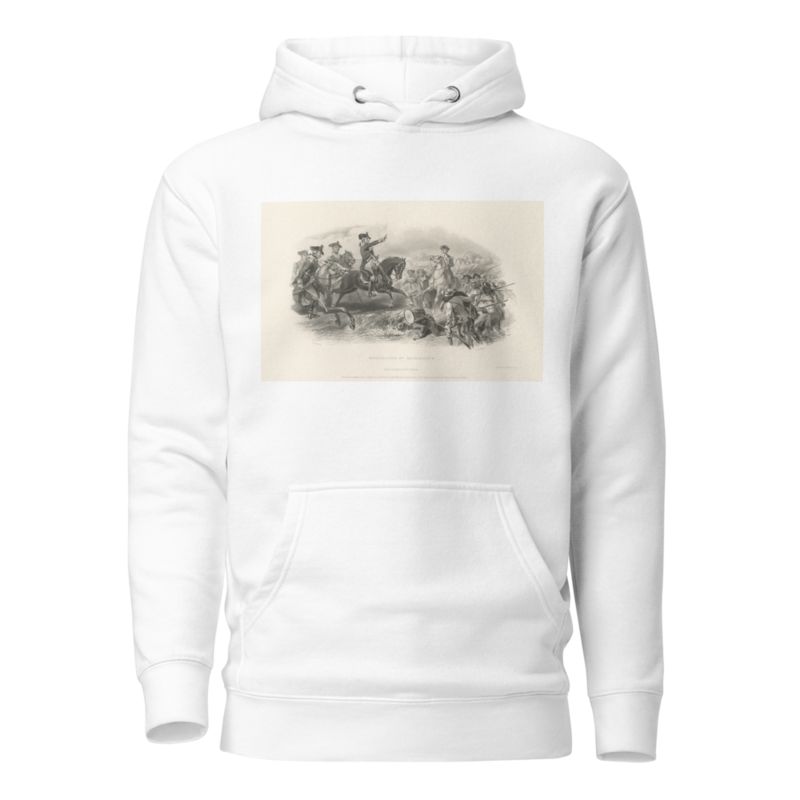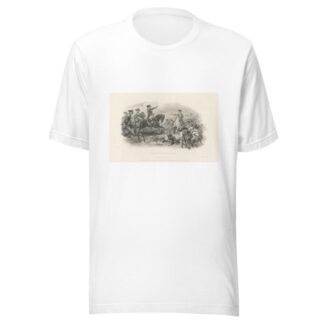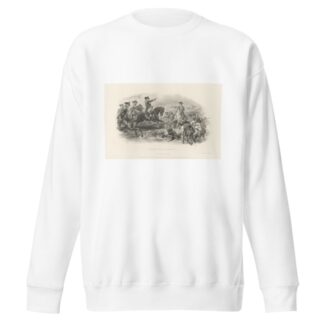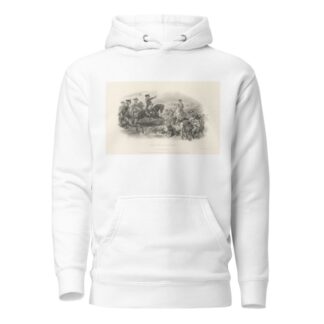Description
Washington at Monmouth. by Felix Octavius Carr Darley printed on a Hoodie
About the Hoodie
Modern fit
It provides a more tailored look than a regular fit
Comfortable
The fabric and fit of this item are extra comfy
Tear-away tag
Easily removable tear-away tag that allows you to add a custom inside label
Premium quality
The product is made from premium, high-quality materials
Classic unisex hoodie with a front pouch pocket and matching flat drawstrings. The 100% cotton exterior makes this hoodie soft to the touch.
- 65% ring-spun cotton, 35% polyester
- Charcoal Heather is 60% ring-spun cotton, 40% polyester
- Carbon Grey is 55% ring-spun cotton, 45% polyester
- 100% cotton face
- Fabric weight: 8.5 oz./yd.² (288.2 g/m²)
- Front pouch pocket
- Self-fabric patch on the back
- Matching flat drawstrings
- 3-panel hood
- Tear-away tag
Felix Octavius Carr Darley (1822 – 1888)
Felix Octavius Carr (“F. O. C.”) Darley was an American illustrator, known for his illustrations in works by well-known 19th-century authors, including James Fenimore Cooper, Charles Dickens, Mary Mapes Dodge, Nathaniel Hawthorne, Washington Irving, George Lippard, Henry Wadsworth Longfellow, Donald Grant Mitchell, Clement Clarke Moore, Francis Parkman, Harriet Beecher Stowe and Nathaniel Parker Willis.
Darley was born on June 23, 1822, in Philadelphia, Pennsylvania. He was a self-taught and prolific artist who started out as a staff artist for a Philadelphia publishing company where he was given a wide variety of assignments.
After he moved to New York, his work began to appear in magazines such as Harper’s Weekly and in books by various publishers. Darley made 500 drawings for Lossing’s History of the United States. Among his lithographic illustrations are those for Irving’s “The Legend of Sleepy Hollow”, and some scenes in Indian life. The swing and vigor of his style, his facility, and versatility and the high average merit of his numerous works, make him one of the most noteworthy of American illustrators.
Darley signed a contract with Edgar Allan Poe on January 31, 1843, to create original illustrations for his upcoming literary journal The Stylus. The contract, which was through July 1, 1844, requested at least three illustrations per month, “on wood or paper as required,” but no more than five, for $7 per illustration. The Stylus was never actually produced but Darley provided illustrations for the final installments of the first serial publication of Poe’s award-winning tale “The Gold-Bug” later that year.
In 1848, Darley provided the drawings for the first fully illustrated edition of Irving’s “Rip Van Winkle”, which was printed and distributed by the American Art-Union. That same year, Darley also illustrated an edition of Irving’s The Sketch Book of Geoffrey Crayon, Gent. and then his Wolfert’s Roost in 1855. Over his career, he produced nearly 350 drawings for James Fenimore Cooper, later collected in a several-volume edition of Cooper’s novels printed from 1859 to 1861. In 1868 he published, after a visit to Europe, Sketches Abroad with Pen and Pencil. His water color paintings of incidents in American history are full of spirit and his bank-note vignettes are also worthy of mention. In 1851, he was elected into the National Academy of Design as an Honorary member, and became a full Academician in 1852.
John Neal Hoover has written a scholarly article on Darley with a section on further reading.
Darley married Genny G. Colburn in 1859. Darley died in 1888 at his home in Claymont, Delaware, and is buried at Mount Auburn Cemetery in Cambridge, Massachusetts. His Victorian mansion, located in Claymont, is now known as the Darley House and was placed on the National Register of Historic Places in 1974.






Reviews
There are no reviews yet.